<p><br> <span class="small">July 30, 2025</span></p>
Travelers lean into AI to enhance their travel and hospitality customer experience
<p><b>Our AI Inclination Index reveals which consumers are most open to using AI in the travel and hospitality journey—as well as where and how they’ll use it. These insights can empower travel and hospitality companies to develop an effective and nuanced consumer-facing AI strategy.</b></p>
<p>For consumers booking a travel experience, the possibilities seem endless. With countless options across destinations, flights, hotels, cruises and experiences, planning a trip can feel overwhelming. It's no wonder that in our recent research, we discovered consumers are greatly interested in using AI tools to dramatically reduce the time and effort it takes to plan a travel experience.</p> <p>Today’s tools can build smart itineraries based on budget, optimal booking windows, preferred climates and the desired balance between activities and relaxation—and even recommend restaurants that fit dietary needs and group size.</p> <p>However, the growing use of consumer AI poses a distinct challenge for travel and hospitality businesses. As they aim to engage customers and capitalize on the opportunity, businesses need to determine which individuals are most (and least) inclined to use AI, their preferred tools and the exact points where AI integration would be most suitable.</p> <p>Using data from <a href="https://www.cognizant.com/us/en/aem-i/new-minds-new-markets-ai-customer-experience" target="_blank">our consumer AI study</a>, we developed the AI Inclination Index, which quantifies consumers’ propensity to use AI (see explainer box below). While the index reveals that consumers are significantly more inclined to use AI in travel and hospitality than in other industries (see Figure 1), that broad finding masks important variations.</p> <p>Consumer attitudes toward AI differ significantly depending on whether they’re learning about, buying or using products and services, as well as which of the travel and hospitality product categories they are pursuing. Our analysis includes:</p> <ul> <li>Packaged travel (holidays, vacations, cruises)</li> <li>Entertainment (shows, tours, activities)</li> <li>Accommodations (hotels, resorts, vacation rentals)</li> <li>Transportation (flights, rental cars, ridesharing, public transport)</li> <li>Dining (restaurants and fast food)</li> </ul> <p><b>Travelers’ appetite for AI isn’t one-size-fits-all. Here's where it spikes and where it slows: </b></p> <ul> <li><b>Consumers’ inclination to use AI peaks in the Learn phase.</b> This is particularly true when it comes to researching options in entertainment, travel packages and accommodations. At the same time, AI inclination scores for travel packages falter in the Buy and Use phases of the customer journey relative to other product and service categories.<br> <br> </li> <li><b>Younger consumers (18–34) are the most compelled to use AI.</b> Typically seen as the most avid technology adopters, younger consumers are more inclined to let AI take the hassle out of travel and hospitality planning and purchasing. Inclination scores for this age group are nearly double those for consumers aged 55 and older, who show greater reservation when it comes to letting AI take the reins.<br> <br> </li> <li><b>Entertainment leads in AI inclination across all purchase phases. </b>AI tools are uniquely positioned to assist consumers in learning about, purchasing and using the wide array of shows, tours and activities available to them at their destinations.</li> </ul> <p><b>The AI Inclination Index</b></p> <p><i>To quantify consumers' propensity to adopt AI-driven technology features throughout the consumer journey, we developed the AI Inclination Index. The index was calculated using three measures from our New minds, new markets survey data.</i></p>
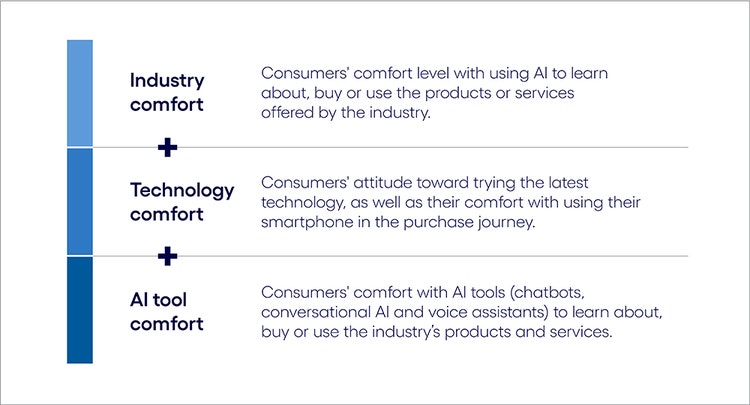
#
<p> </p> <p><b>AI inclination in travel and hospitality vs. the global average</b></p> <p><i>Consumers are more inclined to use AI when purchasing travel and hospitality products and services than other industries’ goods.</i></p>
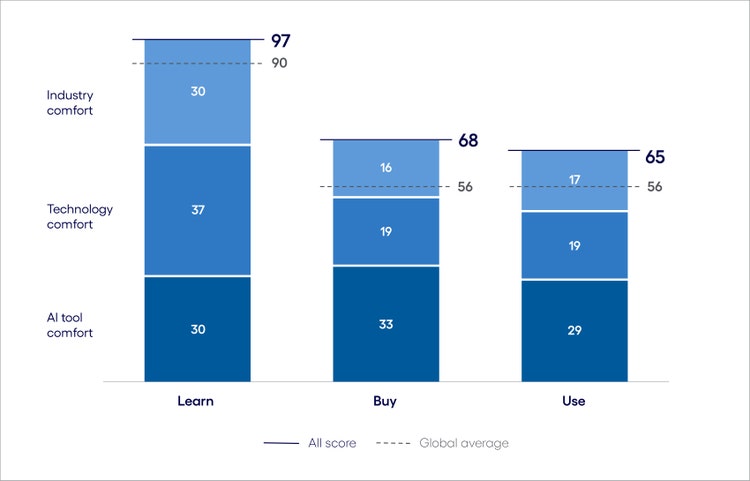
#
<p><span class="small">Figure 1<br> Base: 8,451 respondents in the US, UK, Germany and Australia<br> Source: Cognizant Research</span></p>
<p>It’s clear travel and hospitality businesses will need to craft a precise and nuanced AI strategy that captures opportunity while avoiding low-value pursuits.</p> <p>Understanding consumer use of AI, as well as the accompanying pockets of spending power, is essential for leaders in all industries. In our global study “<a href="https://www.cognizant.com/us/en/new-minds-new-markets-ai-customer-experience" target="_blank">New minds, new markets</a>,” we found that consumers who are enthusiastic about using AI will account for up to 55% of all spending made across industries. This amounts to $4.4 trillion in spending in the US alone and from $540 billion to $690 billion in Germany, Australia and the UK.</p> <p>In this report, travel and hospitality businesses will learn about where in the purchase journey consumers are most and least inclined to use AI, the AI tools they would be most apt to use and how this differs among consumers across age groups. With this information, businesses can reshape their approach to customer engagement—where and how it matters most.</p>
<h4>AI across the travel and hospitality journey</h4> <p>As our AI Inclination Index indicates, consumers are more likely than the global average to use AI across all three stages of the travel and hospitality consumer journey—Learn, Buy and Use. This disparity is particularly high in the Buy and Use phases, where index scores are 19% and 14%, respectively, higher than the global average<b>.</b></p>
<p>But a closer analysis reveals the different dynamics at play between the travel and hospitality product categories in our study.</p> <p>For example, the Learn phase scores highest across all product categories. Entertainment leads the way, with packaged travel and accommodations close behind, while transportation and dining lag.</p> <p>In the Buy phase, consumer interest declines, mirroring trends in our broader cross-industry report. Notably, comfort with technology and industry nosedives by nearly 50% across all products. This decline in comfort highlights a strong unwillingness of consumers to cede control over the ultimate action of pressing the “buy” button. However, these scores remain well above the global average.</p> <p>In the Use phase, the scores decline slightly from the Buy phase. Here, index scores for travel packages, accommodations and dining are all lower than those for entertainment and transportation.</p> <p>These variances among product categories are important to keep in mind as we review how consumers feel about using AI across all purchase stages of the travel and hospitality industry.</p>
About our analysis
To understand consumer AI behaviors and attitudes at a granular level, we structured our analysis around four key pillars:
- The consumer journey. We studied the specifics of AI use at each phase of the customer journey. This journey—how consumers discover, purchase and engage with products and services before and after a sale—is at the heart of the business-customer relationship.
- Consumer demographics. To gain a better understanding of how consumer attitudes and behaviors differ by age group, we divided consumers into five categories: 18-24, 25-34, 35-44, 45-54, and 55+.
- Consumer AI tools. We defined consumer AI use by asking about their intended use of three key tools that are prevalent in the consumer world: voice assistants, chatbots and conversational AI.
- Industry-specific products. We included five travel and hospitality product categories in our analysis: packaged travel, entertainment, accommodations, transportation and dining.
<h5><b>The Learn phase: Endless possibilities spur a surge of AI interest for travelers</b></h5> <ul> <li><span class="eds-label">Near-perfect scores for travel packages, entertainment and accommodations</span><br> <br> </li> <li><span class="eds-label">Technology comfort reaches an all-time high </span><br> <br> </li> <li><span class="eds-label">Travelers under 55 perceive the most value in using AI </span></li> </ul> <p>The discovery phase is where consumers are most inclined to use AI-enabled tools in the travel and hospitality industry. The inclination index score for the Learn phase is 29 points higher than in the Buy phase, and all five product categories are well above the global average (see Figure 2).</p> <p>Whether it’s identifying destinations to match travelers’ ideal getaway criteria or highlighting restaurants that meet their dietary restrictions, AI tools can play a role here in curating the most relevant options. Conversational AI in particular is most often the tool of choice in this stage across the subcategories and across the purchase journey as well.</p> <p>The Learn phase represents a prime opportunity to capture consumer attention and influence decisions. Success begins with understanding what consumers find valuable about AI in this phase—and which AI tools they’re most inclined to use.</p> <p><b>Travel and hospitality AI Inclination Index: The Learn phase</b></p>
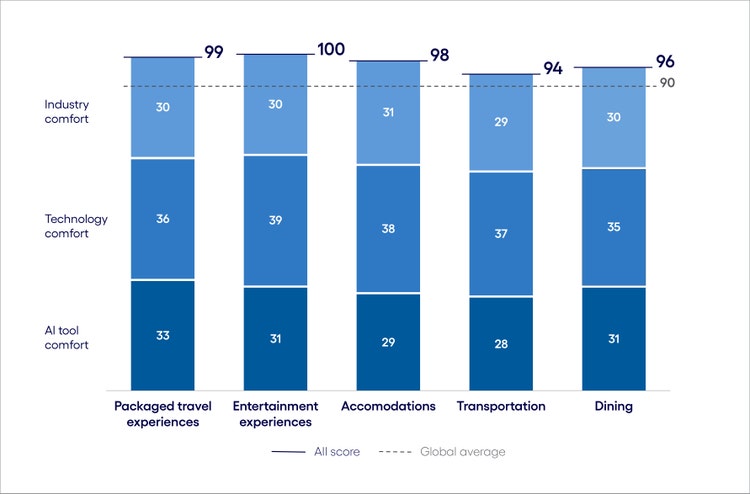
#
<p><span class="small">Figure 2<br> Base: 8,451 respondents in the US, UK, Germany and Australia<br> Source: Cognizant Research</span></p> <p><b>Near-perfect scores for travel packages, entertainment and accommodations</b></p> <p>The strong interest in AI for these product categories is understandable, considering the average consumer spends around 25 hours planning a vacation. AI-powered apps and agents can streamline travel planning by providing personalized recommendations that factor in visa requirements, budgets, timing restrictions and weather conditions.</p> <p>For example, the Roam Around app offers tailored recommendations, real-time information and customizable itineraries based on trip occasion and the duration. Trip Planner AI provides similar functionality, with additional features such as optimized route design and collaborative group-planning capabilities. As AI tools continue to advance, they promise to make travel planning more personalized, efficient and enjoyable.</p> <p><b>Technology comfort reaches an all-time high</b></p> <p>Consumers feel comfortable using AI in the Learn phase partly because they’re already comfortable using digital technology—like smartphones—to research travel and hospitality options. This is reflected in the AI Inclination Index’s technology comfort scores, which are nearly twice as high in the Learn phase as they are in the Buy and Use phases.</p> <p>The preference for fast and convenient information is evident, with over <a href="https://blog.wegopro.com/online-travel-booking-trends-stats/" target="_blank" rel="noopener noreferrer">80%</a> of consumers using their smartphones to research vacation plans, 70% of mobile users seeking activities and 58% making accommodation decisions.</p> <p>As one consumer said, “AI could help me by finding the best deals on holiday packages, comparing flights from different airlines and helping out with the best accommodations. I also feel like AI could be good at informing me about destinations and where [it] is safe or not safe to travel, as well as helping find destinations based on what you want to see, like landscapes, tourism sites or scenery.”</p> <p><b>Travelers under 55 perceive the most value in using AI</b></p> <p>A wide range of consumers—from age 18 to 54—are enthusiastic about using AI to learn about products and services. But interest peaks among 35- to 44-year-olds, who score approximately 15 points higher on average than other age groups.</p> <p>One possible reason for this heightened interest is that these individuals are more likely to be managing family travel, which involves additional planning considerations such as child-friendly accommodations, entertainment options and flexible itineraries. AI tools can help streamline these complexities by offering personalized suggestions that cater to both the needs of adults and children.</p> <p>In contrast, interest in using AI declines among consumers aged 55 and older, with scores falling from 36 for the 35- to 44-year-olds to just 28. Older travelers tend to favor a more hands-on approach, relying on personal experience, traditional resources or recommendations rather than AI-powered tools.</p>
<h5><b>The Buy phase: AI inclination drops for travelers but remains above the global average</b></h5> <ul> <li><span class="eds-label">Top AI enthusiasts are travelers aged 18–44</span><br> <br> </li> <li><span class="eds-label">Packaged travel lags standalone bookings in AI appeal </span><br> <br> </li> <li><span class="eds-label">Comfort with AI voice assistants reaches its height in the Buy phase</span></li> </ul> <p>Decisions in the Buy phase range from high-cost choices—such as flights, accommodations and entertainment—to everyday tasks like booking a restaurant or ordering an Uber. While some are low-stakes purchases, many involve significant financial commitment, leading to greater hesitation among consumers at this stage in the journey.</p> <p>This is why scores across the technology and industry components of the AI index are significantly lower in the Buy phase compared with the Learn phase, although they remain above the global average.</p> <p>Notably, the technology comfort component of the index drops 18 points. This indicates a reluctance to use digital technologies for final travel and hospitality transactions. For example, <a href="https://blog.wegopro.com/online-travel-booking-trends-stats/" target="_blank" rel="noopener noreferrer">80%</a> of Americans prefer to make final travel decisions on a desktop computer, followed by 85% in Germany, 75% in the UK and 67% in France. This highlights a clear contrast between consumers' willingness to use mobile devices for research vs. making the final purchase.</p> <p>Industry comfort is also lower in this phase, reflecting discomfort with handing over control to AI-powered travel apps and websites. As one consumer noted, “I am worried about AI making the overall purchasing decision if it goes beyond my budget or if I’m given recommendations that are not in favor of what I like, especially when something is being pushed toward me because it’s sponsored content.”</p> <p><b>Travel and hospitality AI Inclination Index: The Buy phase</b></p>
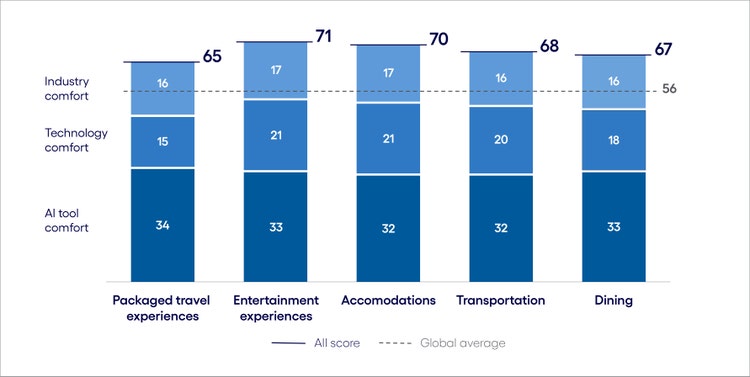
#
<p><span class="small">Figure 3<br> Base: 8,451 respondents in the US, UK, Germany and Australia<br> Source: Cognizant Research</span></p> <p><b>Top AI enthusiasts are travelers aged 18–44</b></p> <p>While scores in the Buy phase are lower than in the Learn phase, inclination to use AI remains 12 points higher than the global average. This is largely driven by consumers aged 18–44. </p> <p>A key AI use case in this phase is helping travelers save money by tracking dynamic pricing on flights, hotels and other expenses. </p> <p>With flight prices changing <a href="https://www.cheapair.com/blog/do-airfares-really-fluctuate-throughout-the-day/" target="_blank">nearly three times a day</a>, and a single seat’s price fluctuating up to 35 times, AI tools offer real value by monitoring real-time data such as competitor pricing and consumer demand to identify optimal booking times. They can then alert travelers when prices are most favorable.<b></b></p> <p>A well-known example of this functionality is <a href="https://www.skyscanner.com/?\&utm\_source=google\&utm\_medium=cpc\&utm\_campaign=US-Travel-Search-Brand-SkyscannerPure-Desktop\&utm\_term=skyscanner\&associateID=SEM\_FLI\_19465\_00000\&campaign\_id=21194284966\&adgroupid=167931046984\&keyword\_id=kwd-400074527\&gad\_source=1\&gad\_campaignid=21194284966\&gclid=CjwKCAjwl\_XBBhAUEiwAWK2hzpqQFPwf\_K8z\_mMjvZOmbZ7mbbS3C2rteQOi00ZucGSkeyAzWWn8zBoCrXcQAvD\_BwE\&gclsrc=aw.ds" target="_blank">Skyscanner</a>, which uses AI to track and predict price changes, offering users personalized alerts and recommendations. As consumers become more budget conscious and value driven, the ability of AI to deliver timely, data-informed insights makes it an increasingly trusted companion in the travel booking process.</p> <p><b>Packaged travel lags standalone bookings in AI appeal</b></p> <p>While consumers are inclined to use AI for individual tasks—like booking accommodations or entertainment—they’re hesitant to trust it with complex, interconnected needs like full travel packages.</p> <p>Packaged travel experiences often include lodging, food and beverages, entertainment and transportation. For these more complex trips, consumers seem to prefer human—and often local—insight. They worry that AI might miss personal nuances that are hard to articulate in a search. As one consumer explained, “If you're an avid traveler, you would want the hidden spots that AI would not be able to know because it doesn't know to look for that.”</p> <p><b>Comfort with AI voice assistants reaches its height in the Buy phase</b></p> <p>AI voice assistants score highest during the Buy phase, particularly in the dining category, where they outperform even conversational AI. This preference likely stems from the convenience and speed these assistants offer in completing transactional tasks. Technologies like Google Assistant allow users to make reservations through simple voice commands, eliminating the need to manually search, compare and book.</p> <p>Voice assistants’ deep integration with platforms such as OpenTable, Yelp and various travel booking services enables them to quickly navigate multistep processes. As AI voice assistants continue to evolve, their ability to manage complex tasks using natural language makes them a powerful asset in travel and hospitality, particularly at the point of purchase when convenience matters most.</p>
<h5><b>The Use phase: Travelers’ AI inclination is high for post-sale needs</b></h5> <ul> <li><span class="eds-label">Conversational AI returns as the tool of choice</span><br> <br> </li> <li><span class="eds-label">AI interest is highest for entertainment experiences</span><br> <br> </li> <li><span class="eds-label">High-income travelers lead AI adoption during the Use phase</span></li> </ul> <p>During the Use phase, consumers rely on AI to maximize their travel experiences. AI can assist with navigating cancellations and rebookings in real time, offer route optimizations and accessibility information for events, and adjust itineraries based on weather, traffic and local events.</p> <p>These post-sale capabilities help enhance consumer enjoyment of their travel and hospitality experiences, allowing more time for relaxation and less time spent troubleshooting with customer service representatives.</p> <p>As a result, AI index scores remain steady from Buy to Use, particularly for entertainment, transportation, accommodations and dining, where scores surpass the global average (see Figure 4).</p> <p>However, in other categories like travel packages, consumers are less inclined to see the value of AI. And as with other phases, there are big differences among consumer groups.</p> <p><b>AI Inclination Index: The Use phase</b></p>
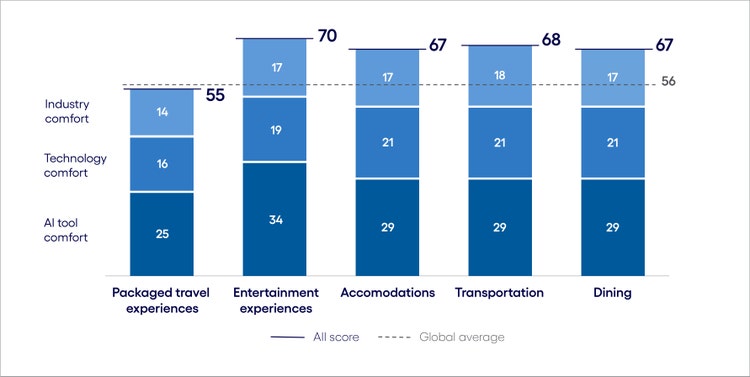
#
<p><span class="small">Figure 4<br> Base: 8,451 respondents in the US, UK, Germany and Australia<br> Source: Cognizant Research</span></p> <p><b>Conversational AI returns as the tool of choice</b></p> <p>Conversational AI continues its lead as the favored AI tool in the Use phase, where travelers actively engage with services during trips or outings. Its strength lies in its ability to respond to a wide range of real-time needs through natural, intuitive interactions.</p> <p>For example, <a href="https://www.phocuswire.com/expedia-launches-virtual-agent-for-advisors-and-travelers" target="_blank" rel="noopener noreferrer">Expedia’s Virtual Agent</a> helps travelers with itinerary changes, cancellations and refunds via natural language processing. By analyzing travelers’ past behaviors and preferences, the virtual agent determines the best course of action to address their needs, helping to resolve issues quickly and effectively. Nearly 50% of Expedia’s customers have used the agent, underscoring the growing need for intelligent agents in the market.</p> <p>This experience contrasts with traditional last-gen chatbots, which follow a structured question-and-answer approach and often lack the nuance to address travelers’ needs.</p> <p><b>AI interest is highest for entertainment experiences</b></p> <p>Consumers overwhelmingly recognize AI’s role in enhancing entertainment experiences during the Use phase, with index scores exceeding both the global average and all other product categories in our study. This likely reflects the many ways AI can be applied in this context.</p> <p>AI can assist with sending reminders of events, providing directions to venues, offering real-time language translations and even dynamically rescheduling based on changes in availability or preferences. It could also provide important information on things like dress code, weather and accessibility.</p> <p>By providing this information proactively and based on the individual user’s personal needs, AI tools could empower consumers to focus on enjoying their experiences and less on logistical concerns.</p> <p><b>High-income travelers lead AI adoption during the Use phase</b></p> <p>Consumers earning $80,000 or more annually score 10 points higher in AI inclination than low- and medium-income consumers. This gap may stem from the fact that while many AI travel tools are free, advanced features—such as concierge-level support, predictive pricing and VIP access—are typically offered through paid tiers.<br> <br> These premium options are more affordable for higher earners, which may explain their increased engagement with AI tools at this stage.</p>
<h4>Meeting travelers where they are in the travel and hospitality journey</h4> <p>Consumer use of AI is growing fast, along with the rise of AI agents that function like personal digital concierges, orchestrating complex tasks across the purchase journey. Soon, the internet will evolve into the “agentic internet”: an interconnected ecosystem where AI-enabled tools and agents autonomously find, evaluate, purchase and maintain the products and services consumers rely on. </p> <p>With consumer AI uptake in travel and hospitality higher than the global average, we believe industry leaders have less than five years to navigate this change.</p> <p>To prepare for the AI-driven consumer era ahead, travel and hospitality businesses will need to rethink how they operate across these four key areas:</p> <ul> <li><b>Replace last-gen chatbots with conversational AI. </b>Although chatbots have traditionally been the most widely used AI tool for customer service, consumers increasingly express a preference for more sophisticated solutions.<br> <br> Unlike basic chatbots, which rely on predefined commands and scripted responses, conversational AI leverages advanced technologies like natural language processing and machine learning to interpret and respond to questions in a more personalized and context-aware manner. This allows consumer questions to be addressed more accurately and in a way that enhances customer satisfaction when troubleshooting travel and hospitality queries.<br> <br> </li> <li><b>Build trust by starting with AI for individual, not packaged, travel experiences. </b>Consumers are wary of using AI for travel packages, likely perceiving the interconnected elements of accommodations, transportation, dining and entertainment as too high-risk and complex to manage without human oversight.<br> <br> Businesses could start building trust for all-inclusive experiences by focusing first on a single travel and hospitality product category, such as accommodations and then growing their AI capabilities from there.<br> <br> </li> <li><b>Look for points of interconnection within the travel ecosystem. </b>Whether domestic or international, travel involves many moving parts. From airlines and transportation to reservations for dining, entertainment and hotels, nearly every step generates a receipt or confirmation number that must be accessible on-demand.<br> <br> The result for many travelers is a disconnected experience, with lots of scrolling through emails or screenshots to retrieve these details when needed. While some platforms can manage multiple aspects of a trip, most focus on individual components. Agentic AI has the potential to unify these fragmented elements into a single, streamlined view and go even further by managing the entire journey from start to finish. <br> <br> For example, if your flight is canceled with no same-day alternatives, agentic AI could automatically rebook you on the next available flight, reserve a hotel nearby, arrange airport transportation and adjust your destination itinerary, while still prioritizing your top sightseeing interests.<br> <br> Travel and hospitality companies that embrace the next wave of agentic AI and proactively plan for the integrations needed to execute this streamlining across both first- and third-party data will be better positioned to lead the way to a more seamless travel experience.<br> <br> </li> <li><b>Focus on all three stages of the consumer journey. </b>While many AI-powered tools are geared toward helping consumers tackle their customer service needs, businesses should not overlook the broader consumer journey. Focusing exclusively on optimizing the Use phase, where customer service experience typically occurs, can lead to critical oversight of the Learn and Buy phases that precede it.<br> <br> If businesses fail to engage consumers early in the journey using AI, they risk significantly reducing the number of users who ever reach the Use phase. This not only limits the impact of their customer service investments but also weakens brand loyalty and conversion rates.<br> <br> In essence, a narrow focus on post-purchase support ignores the compounding value of AI when applied across the lifecycle. To truly unlock AI’s potential, companies must harness the information they gather in the Use phase to help create a feedback loop that enhances consumer experiences in Learn and Buy. By doing this, the rich data received in this stage can be used to leverage AI to its fullest extent across the purchase journey.</li> </ul>
Jump to a section
Introduction #spy-1
AI across the travel and hospitality journey #spy-2
subnav- The Learn phase: Endless possibilities spur a surge of AI interest for travelers#spy-3
subnav- The Buy phase: AI inclination drops for travelers but remains above the global average#spy-4
subnav- The Use phase: Travelers’ AI inclination is high for post-sale needs#spy-5
Meeting travelers where they are in the travel and hospitality journey #spy-6
<h5>Authors</h5>




